Issue 3, May 20, 2020
Asian Giant Hornets: Your Questions Answered
On May 3, 2020, articles and videos discussing the first instance of Asian giant hornets (Vespa mandarinia) identified in the US began to run in the national news. These headlines have raised concern about this animal and may leave some wondering if they have seen it or if we need to worry about it in Illinois. Here are the answers to some frequently asked questions about Asian giant hornets:
Where has Asian giant hornet been found in North America?
In September 2019, a nest of Asian giant hornets was found and destroyed on Vancouver Island in British Colombia, Canada. In Washington State, there were 3 photo sightings, each of a single hornet, in August, October and December of 2019. The December photo was of a dead hornet that was later submitted to experts and confirmed as an Asian giant hornet. This hornet was the only confirmed Asian giant hornet in the US.
What is being done to detect and remove them?
Washington State Department of Agriculture has already begun monitoring the areas where the hornets were sighted and the surrounding counties to determine if any hornets are present. Monitoring efforts include traps baited with food or pheromone attractants to capture foraging adults and infrared monitoring to identify potential nest sites. If Asian giant hornets are identified, they will be eradicated. There have been no sightings or trap captures so far in 2020.

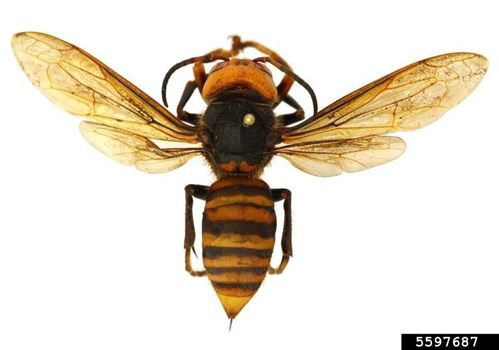
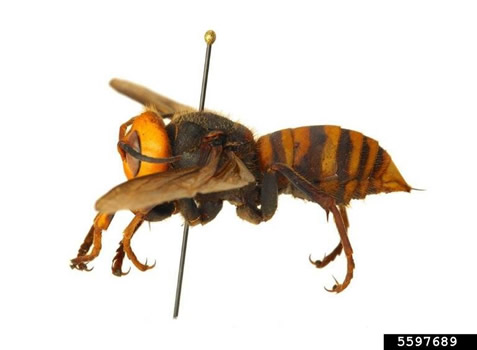
Asian giant hornet (Vespa mandarinia), Washington State Department of Agriculture , Washington State Department of Agriculture, Bugwood.org
Where is the hornet from and how did it get to the US?
Asian giant hornets are native to forested areas in east Asia and southeast Asia. They occur in multiple countries but are most common in Japan. It is unclear how the hornets arrived in North America.
Are they in Illinois?
No.There have been no reports of Asian giant hornet in Illinois or anywhere in the US outside of Washington State. The hornets are not capable of reaching Illinois without being transported by humans. If a sighting is ever confirmed in Illinois, the United States Department of Agriculture, Illinois Department of Agriculture and University of Illinois at Urbana-Champaign will release a Pest Alert to notify the public and the media.
How can they impact human health?
Like our native hornet species, Asian giant hornets only sting if they are threatened or defending their nest. These hornets may also defend the nests of other insects they intend to use as food for their young, creating an additional situation where they could feel threatened and sting. Asian giant hornets feed on honey bees (Apis mellifera), so beekeepers are more likely to encounter these hornets. Beekeeping protective clothing is not thick enough to prevent stings from this hornet so beekeepers should not approach the hornets.
The media has reported that people can be killed by Asian giant hornet stings. This is not the normal outcome of a single sting. Most people who have died after being stung by this insect were stung many times or had allergic reactions. This hornet’s venom is similar to that of other hornets but, because it is so large, it injects more venom and can have a greater impact on human health. Protecting people is one of the primary goals in monitoring and controlling these insects.
How can they impact honey bees and wildlife?
While adult Asian giant hornet workers feed on sweet foods like fruit and sap, they collect protein-rich foods to feed their larvae. These foods are usually other insects, including honey bees. Unlike Asian honey bees (Apis cerana) in the hornet’s native range, European honey bees in the US, are unable to defend themselves against this predator. A group of worker hornets can enter a honey bee hive and kill nearly all of the bees inside, but this only occurs in the late summer, when the hornets are collecting food for their young. In Japan, screens or small bars are placed over hive entrances to allow the bees to come and go but prevent hornets from entering. Currently, we do not know how these hornets could impact native bees or other wildlife. Protecting wildlife and honey bees are among the main reasons to closely monitor and control the hornets.
What should I do if I see one?/
If you think you have seen this animal, do not approach it or attempt to remove a nest without professional help. Instead, contact University of Illinois Extension and let them know what you have seen. There is a good chance that the insect you are seeing is European hornet, baldfaced hornet or eastern cicada killer, which are all large wasps that occur in Illinois. Extension educators can provide identification and notify Illinois Department of Agriculture and United States Department of Agriculture if necessary.
European hornet
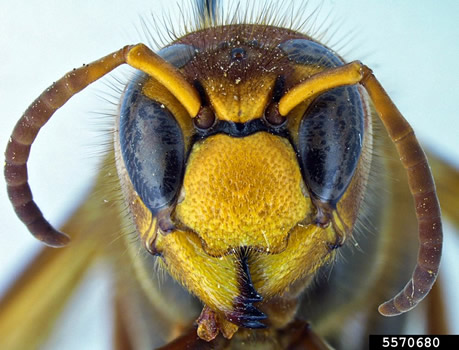
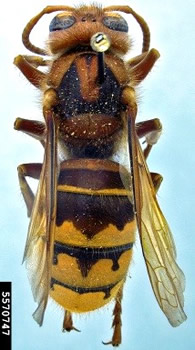

European hornet (Vespa crabro), Allan Smith-Pardo, Invasive Hornets, USDA APHIS PPQ, Bugwood.org
European hornet (Vespa crabro) was introduced to the US in the 1800s as a biocontrol agent and has become established in the Northeast, South and parts of the Midwest, including Illinois.
European hornet is about 1 inch long with a yellow and black abdomen. The black bands on the abdomen extend into a V-shape over the center of the first few segments. Each abdominal segment has a black spot on the left and right side. For comparison, the Asian giant hornet is 1.5 – 1.75 inches long and noticeably bulkier than our local hornets. Asian giant hornet has an orange head and an abdomen with orange and black stripes, so if the wasp you see has strong yellow coloration on the abdomen, it is more likely a European hornet.
The nesting sites of these species also differ. European hornets usually nest in tree holes but Asian giant hornet is a ground nesting species that may choose a nesting site in an abandoned animal hole in a forested area.
European hornet is unlikely to sting but may approach or bump into a person to intimidate them so they leave the area. They usually only sting if handled or stepped on.
Baldfaced hornet
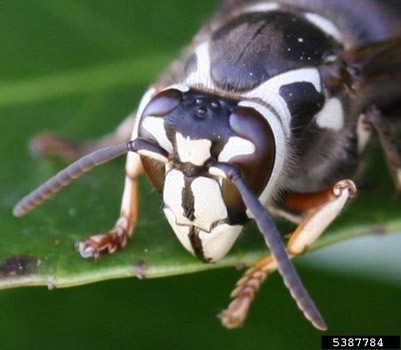
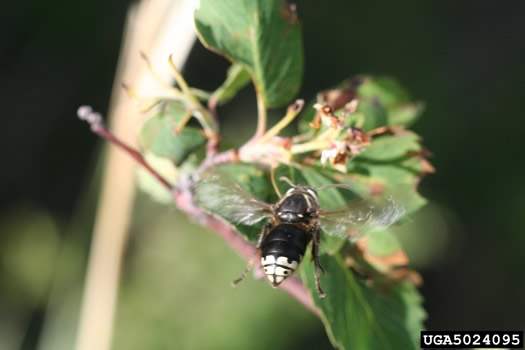
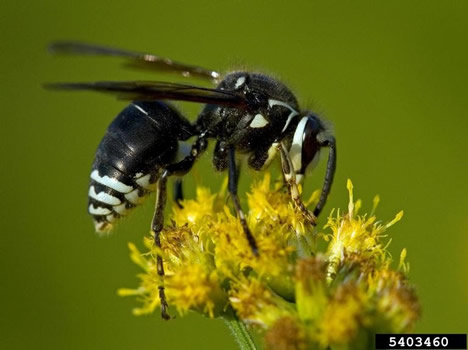
Left: Baldfaced hornet (Dolichovespula maculata), Johnny N. Dell, Bugwood.org
Center: Baldfaced hornet (Dolichovespula maculata), Whitney Cranshaw, Colorado State University, Bugwood.org
Right: Baldfaced hornet (Dolichovespula maculata), David Cappaert, Bugwood.org
Baldfaced hornets (Dolichovespula maculata) are found throughout most of North America. They are 0.5 - 0.8 inches in length and appear bulkier than other native wasps of a similar size. Adults have a black body with distinct white markings on their head and white banding on the last few segments of their abdomen. Asian giant hornets are at least twice the length of the average baldfaced hornet worker and at least twice as wide. Asian giant hornet has a bright orange head and an abdomen with orange and black stripes. While baldfaced hornets appear bulky and proportionately similar to Asian giant hornets, the white markings on the head and abdomen will let you know that you have encountered baldfaced hornet and not Asian giant hornet.
Baldfaced hornets build papery football-shaped nests on tree branches or shrubs. The nests are positioned at least 3 feet above the ground and some can be located very high in trees. In contrast, Asian giant hornets nest in the ground in forested areas.
Like many bees, wasps and hornets, baldfaced hornets will sting if they feel threatened or if their nest is disturbed. However, they are a species of yellowjacket and like other yellowjackets, they may feel threatened and sting if you are too close to a nest or if they are swatted or otherwise threatened while foraging. It is a good idea to avoid baldfaced hornet and yellowjacket nesting sites and give foragers a respectful distance.
Eastern cicada killer
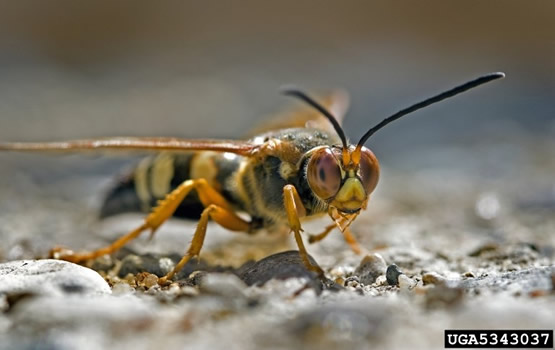
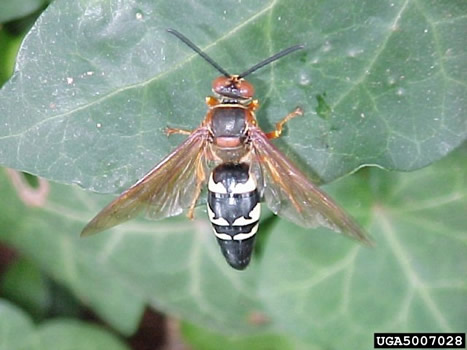

Left: Cicada killer (Sphecius speciosus), David Cappaert, Bugwood.org
Center: Cicada killer (Sphecius speciosus), Nancy Hinkle, University of Georgia, Bugwood.org
Right: Cicada killer (Sphecius speciosus), Jim Occi, BugPics, Bugwood.org
Eastern cicada killers (Sphecius speciosus) are large wasps native to most of the eastern US. The cicada killer is 1.5 inches long, with a red to brown head and a black abdomen with uneven yellow banding. The Asian giant hornet is similar in length measuring 1.5 – 1.75 inches long but much bulkier. Asian giant hornet has an orange head and an abdomen with orange and black stripes.
Their nesting sites also differ from those of the Asian giant hornet. Cicada killers are not social insects, each female digs a hole in an open area with bare soil where she rears her young. Female cicada killers collect cicadas and bring them back to their hole to feed the young. Asian giant hornets are eusocial, with many individuals living in a nest and working together to rear their young. Asian hornets prefer to nest in the ground in forested areas away from open areas and humans.
Male cicada killers defend a territory where they may approach people who pass within the boundary. While this is an intimidating behavior, male cicada killers do not have a sting and cannot harm you. Female cicada killers do have a sting but usually do not approach people and only stings if handled or stepped on.
Additional Resources:
Asian giant hornet and human health. Washington State Department of Agriculture. https://agr.wa.gov/departments/insects-pests-and-weeds/insects/hornets/agh-human-health
Asian giant hornet fact sheet. 2020. Susan Cobey, Tim Lawrence and Mike Jensen. Washington State University Extension. https://s3.wp.wsu.edu/uploads/sites/2091/2020/04/AGHPreReview4Factsheet.pdf
Asian giant hornet: What gardeners need to know. Washington State Department of Agriculture. https://cms.agr.wa.gov/WSDAKentico/Documents/Pubs/831-AsianGiantHornet-FactSheet-Gardeners.pdf
Asian giant hornet: What outdoor workers need to know. Washington State Department of Agriculture. https://cms.agr.wa.gov/WSDAKentico/Documents/Pubs/834-AsianGiantHornet-FactSheet-OutdoorWorkers.pdf
New pest response guidelines. 2020. Amber Tripodi and Trace Hardin. United States Department of Agriculture. https://cms.agr.wa.gov/WSDAKentico/Documents/PP/PestProgram/Vespa_mandarinia_NPRG_10Feb2020-(002).pdf
Sizing up the Asian giant hornet. Washington State Department of Agriculture. https://agr.wa.gov/departments/insects-pests-and-weeds/insects/hornets/size-comparisons
Author:
Sarah Hughson